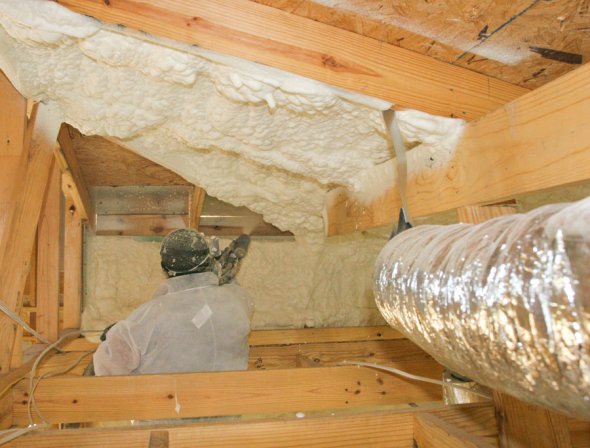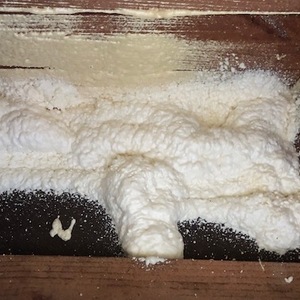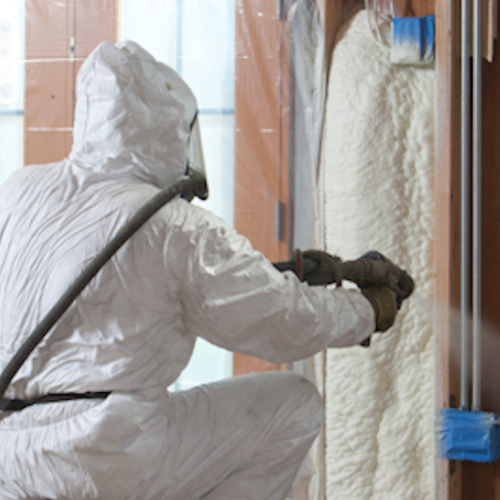
Federal lawsuits claiming that spray-polyurethane foam insulation is toxic and can sicken those who live in houses where it has been installed are pending in more than a half-dozen states as lawyers deal with an “avalanche” of complaints, a Florida attorney says.
To date, complaints have been filed in federal district courts in Florida, New York, Michigan, New Jersey, Connecticut, Wisconsin, and Pennsylvania, says Vince Pravato, an attorney at Wolf & Pravato in Fort Lauderdale. According to Pravato, litigation filings are also expected in North Carolina and Arkansas.
Pravato says he has been retained by clients to pursue claims against a number of different manufacturers and installers, including Demilec, Lapolla, Masco, and NCFI Polyurethanes.
The filings mark the start of what is likely to be a protracted legal effort on the part of a number of attorneys representing many homeowners. Attorneys for the homeowners are hoping the cases will be bundled into something called “multidistrict litigation” that would speed pretrial proceedings. A hearing on that request is scheduled for the end of May in Kentucky.
Verdicts in any of the requested jury trials could be a year or more away.
Some clients suffer ‘severe health issues’
Pravato was one of the attorneys working on litigation that targeted defective drywall manufactured in China and installed in thousands of homes in the U.S.
Class action settlements approved in that case could cost the manufacturer more than $1 billion. “I was not eager to jump into another situation like the Chinese drywall case,” Pravato says, “but more and more people began contacting me and I said I would look into it, and it became an avalanche.”
The chief complaints are health problems suffered by occupants of homes that have been insulated with spray foam. Apparently, some homeowners develop chemical sensitivity to foam ingredients.
While a number of manufacturers have been cited, Demilec comes up most frequently, Pravato says. Most often, the affected homeowners were in their homes at the time the foam was sprayed, or returned home immediately afterward. Clients who developed health problems typically didn’t know what was causing them. Plaintiffs include a family doctor from Virginia, Pravato says, who was forced out of his home.
“He had significant neurological problems,” the attorney says. “He had MRI testing because he was losing sensation in his legs. He had breathing problems. He was seeing an allergist. He couldn’t figure out what the problem was, and he was a medical doctor. He said, ‘Vince, if somebody came to me with these problems and said it was spray foam I wouldn’t believe him.’ And he finally figured out what it was. They moved out and he’s doing much better. But his house sits empty.
“When you hear these stories it’s just a tragedy after a tragedy. These people are losing their homes. It’s terrible story after terrible story.
“I think there are a lot of people out there who are having problems and don’t know why they are having problems,” he adds. “This hasn’t become a giant public concern so far. You don’t have a lot of news coverage on it. I don’t think people really have the tools to know what is the cause of a lot of the problems they may be having.”
Two-part foam that must be applied carefully
Spray polyurethane foam has become a popular insulation option, especially in high-performance houses. Although relatively expensive, it seals cracks and seams in wall and ceiling cavities much better than batt insulation.
Foam comes in two varieties, open-cell and closed-cell, each with slightly different properties and different R-values. Of the two, closed-cell foam is a better insulator, with R-values of about 6.5 per inch. Once cured, it also becomes a vapor retarder. Open-cell foam has a lower R-value, roughly 3.5 per inch, and although it acts as an air barrier, it’s not an effective vapor barrier. According to Pravato, open-cell foam is the target of more of the complaints than closed-cell foams.
But both are applied in fundamentally the same way. They consist of two chemicals that are mixed in the head of the installer’s spray gun and expand on contact. Once the foam cures, it’s designed to become an inert material that’s benign to homeowners.
The complaints allege that in some cases, the foam is toxic. “When applied, the resulting polyurethane foam is supposed to become inert and non-toxic,” reads a Florida complaint naming Demilec’s “Sealection” insulation, “but SPF remains toxic after installation because either, as designed, it is impossible to become inert and non-toxic even under optimal conditions; or proper installation (and thus non-toxicity) is nearly impossible given the exacting set of installation requirements and inadequate training and installer certification methods …
“Due to the defective nature of Demilec’s design and manufacture of SPF, the defective nature of Demilec’s training of distributors/installers, and the defective nature of Demilec’s warnings, labeling and training materials, the application and installation of SPF is anything but ― controlled, resulting in the installation of an SPF that causes property damage and health hazards to occupants of installed homes such that the only remedy is the complete removal of the SPF.”
The complaint cites Demilec’s own instruction manual for installers, notably the company’s warning that applying the foam required “strict adherence” to approved techniques and that a “regular maintenance program must be followed and temperatures must be scrupulously respected.”
The complaint alleges that Demilec knew its certified installers were “not fit” to do their jobs and that training and supervision were inadequate.
No known method of remediation
Once installed, spray polyurethane foam is very difficult to remove, Pravato says, complicating the situation for homeowners who develop chemical sensitivities as well as clouding the eventual outcome of the court cases.
“Our goal is to find ultimately a remediation process for these homes,” he says. “EPA right now acknowledges that there isn’t any safe way to remediate the homes. I have several clients who have tried to remediate and have been unsuccessful.”
Efforts have included something called “ice blasting” in which shards of ice are shot at installed foam at high speed, essentially abrading it away from any surface where it’s been applied. But, Pravato says, the foam breaks into very small particles and spreads easily, making the situation potentially worse than it was.
One client in Florida whose home was sprayed with foam only in the roof is proposing to lift off the entire roof intact, without disturbing the foam, and replacing it with a new one. Another client, Pravato says, scraped away most of the foam in his roof but still experiences problems when the summer heat warms the remaining foam.
Spray foam is the focus of many homeowner complaints
There’s nothing new about homeowner complaints that a fish-like chemical odor lingers for months after spray foam has been applied.
In 2011, GBA senior editor Martin Holladay interviewed eight homeowners who’d experienced problems with spray-foam applications. In a few cases, unpleasant odors persisted despite attempts to remove foam that appeared faulty, or attempts to spray over it to seal it in.
In some cases, manufacturers tried to blame the smell on other substances that might have been in the house, and their efforts to get to the root cause of the problem and correct it were spotty at best.
In Holladay’s interviews, Demilec was frequently cited as the foam manufacturer. “We’ve had a lengthy ordeal with representatives from Demilec,” Florida homeowner Mike Roth told Holladay. “Their agenda was to prove there was something else in the house causing the smell and it wasn’t their problem.”
Roth is one of the homeowners represented by Pravato’s office.
Reports of low air quality and impacts on health also have cropped up a number of times in other GBA posts and Q&A threads. Homeowners shared remarkably similar stories.
Response from manufacturers
GBA made attempts to contact representatives of Demilec, Masco, Lapolla, and NCFI Polyurethanes. Voice messages, or in some cases e-mail requests for comment, were not returned.
GBA also messaged the Spray Foam Coalition, an association of companies that make and sell spray polyurethane foam, for comment.
GBA received this response:
“The Center for the Polyurethanes Industry (CPI) and the Spray Foam Coalition (SFC) are aware of recent cases involving spray polyurethane foam. Our members are committed to the health and safety of polyurethane products, which includes spray polyurethane foam (SPF), and those who use them.
“According to the U.S. Environmental Protection agency, after SPF is correctly applied and cured, it is considered to be relatively inert, which means the chemicals are finished reacting. When having SPF installed, homeowners should talk to their professional contractor about the product’s curing time and appropriate safety precautions.
“The SPF industry has for many years and will continue to support the safe and appropriate use of SPF; moreover, the industry works with regulators, researchers, producers and applicators to ensure that those using SPF have access to information they need about how to use the product safely. Along with government agencies, researchers and other relevant experts the SPF industry works to provide the best information available about the health and safety aspects of SPF and identify where additional research could be conducted. Industry leaders and organizations work together to provide free health and safety training to professional contractors and anyone interested in learning more about the product, as well as a library of other free resources [may go] here.”
The statement also said the Spray Polyurethane Foam Alliance recently launched a professional certification program, which “will continually raise the bar on safety, performance, quality and professionalism.”
Efforts to streamline the court cases
The plaintiffs’ attorneys, including Pravato, will seek “multidistrict litigation” (MDL) status at a hearing in May. If granted, a single federal judge would be able to rule on pretrial questions common to all similar complaints no matter where they were filed.
Unlike a class-action lawsuit, these multidistrict cases would be heard by juries in the courts where they were originally filed. In a class-action, a single case that goes all the way through trial settles all similar cases for plaintiffs in the same class.
Pravato says the multidistrict designation is a way of getting consistent rulings on common legal questions while making the legal process more economical. “If you have 20 different judges hearing these matters you may have all types of different rulings on different issues,” he says. “Having everything consolidated in front of one judge will streamline the entire process and it will give the cases consistency.
“It’s very difficult to file individually against these giant chemical companies,” he continues. “They have the deep pockets, and the recovery for an individual home makes it very difficult for a law firm to get involved and hire the type of experts you need.
“Let’s say the damages are only $200,000 to a home. If you have to spend $100,000 in expertise to hire chemists and various experts you need to prove your case, it almost becomes prohibitive to bring you case against these manufacturers and installation companies.”
If the cases do win MDL status, Pravato says a few “bellwether” trials could be fast-tracked all the way through jury trials within a year, with findings used to shape a potential settlement.
Attorneys are seeking to have the multidistrict cases heard in a southern Florida federal court by Judge Kenneth A. Marra.
Weekly Newsletter
Get building science and energy efficiency advice, plus special offers, in your inbox.















9 Comments
Timely article
We made a decision to minimize the use of spray foam in our new house because of reports of owners becoming chemically sensitive. At the same time, we have trouble finding practical alternatives to foam in certain areas of the house such as the band joist. The roof is another problem area since we have cathedral ceilings planned for the second floor. Polyurethane SIPs seem to be our best option there. As far as I know, manufactured SIPs are not subject to the issues mentioned in the article.
I have some concerns about using rigid foam in the basement because of the fire retardants that typically contain.
Polyurethane SIPs are a travesty! (response for Steven Knapp)
Unless the manufacturer will stipulate that they are using only one of the few very low global warming potential (GWP) blowing agents, it a net negative for the environment. Most polyurethane is blown with high GWP HFCs, usually HFC245fa with more than 1000 x CO2 GWP. In a high-R application the total lifecycle hit from the blowing agents greater than the energy use it's offsetting. When used in modest layers for moisture control in multi-insulation stackups or for air sealing it can eventually break even, but in high-R applications where it's the primary insulation, the environmental break-even point is "never".
Until they change blowing agents, polyurethane SIPs are the chromatic opposite of "green", independently of any toxicity/sensitivity issues.
EPS SIPs
Steven, Dana,
What about using SIPs made with Expanded Polystyrene foam? EPS(Styrofoam) uses Pentane as a blowing agent. Pentane has a GWP of 7 rather than 1000+ for polyurethane. They are available in panels that will offer between R42-R48 @12" thick.
I believe they use the same flame retardants as other foams, but they do have a much lower footprint in terms of embodied energy.
Many people (some on this site), will advise that you steer clear of foam all together and that you can build just as good, or better, with a foam-free design. I agree, but I still like SIPs. If you're planning on using them, I'd look into getting those with EPS foam instead.
(Corrected for R value. Never trust one manufacturer's claim.)
Re: Polyurethane SIPs are a travesty!
Dana, can you share scientific data on your statement on the lifecycle hit? That would be very helpful. Thank you in advance
Response for Marco
Not great on the quantitative science, but the essential facts are correct:
http://www2.buildinggreen.com/blogs/avoiding-global-warming-impact-insulation
Better on the particulars regarding polyurethane foams using a proprietary low GWP blowing agent:
http://www.honeywell-solsticelba.com/wp-content/uploads/2012/11/pu-magazine-solstice-lba-artcles.pdf
Yes, pentane blown polyiso and EPS are DRAMATICALLY lower impact than HFC245fa blown polyurethane. SFAIK no US polyurethane SIP vendor to date uses either Honeywell Solstice or DuPont FEA-1100 low-GWP blowing agent for polyurethane.
If going with PU-SIPs, make them declare which blowing agents are used, and look it up. The GWP of HFC245fa and HFC134a (two of the most common HFCs for blowing foam) are well documented and easily found in online searches, as are the GWPs of the most commonly used refrigerant-HFCs. Some proprietary mixes with trade-names may not be as easy to find data on, but they should be able to get you the GWP data on them- if not, pass.
(edited to add)
A bit blocky, but some info on FEA-1100 relative to other common blowing agents:
http://www2.dupont.com/Formacel/en_US/assets/downloads/UTECH_presentation_20090331.pdf
Short spec-sheet for FEA-1100:
http://www2.dupont.com/Formacel/en_US/assets/downloads/white_paper_FEA-1100.pdf
At the same time, we have
Balloon-frame the house and fill the cavity with rockwool; Balloon-frame has no rim joists and rockwool solves the fire issue with that framing method.
Use 16" TJIs and fill them with rockwool or cellulose.
Response to Chris Gleba
Chris,
Your suggestion to use rock wool or cellulose for a cathedral ceiling will work fine, as long as the installer includes a ventilation gap between the top of the insulation and the underside of the roof sheathing.
Your suggestion to use rock wool to insulate rim joists, however, will not work in a cold climate. Rock wool insulation is air-permeable, and the insulation will allow warm, moist interior air to contact the cold rim joist. The result will be a damp rim joist -- and eventually, mold and rot.
Or insulate the rim joists with exterior insulation so they are not cold.
This is actually what I also
This is actually what I also care about, that brand name as well as company name is always at risk when the service or the products bears issues like this. Personally, the business I run is well manage and wish not to be in this kind of crisis, so thanks to http://eatmywords.com/services/consulting/, I am at peace doing better business.
Log in or create an account to post a comment.
Sign up Log in